Text


Group members:
Sabrina willis
Dougie Chalmers
Paris Davies
Harry Tozer
2 notes
·
View notes
Text
Artists statement
Our installation 'Eye of the storm' focuses on artificially replicating the natural world to create an immersive, sensory experience, exploring both our individual relationship with nature and how ecologies are adapted through the human presence.
Working with our main senses of sight, hearing and touch we aimed to construct the essence of a storm within an enclosed room, and provoke the individual emotive responses to nature through it's experience.
The room is left in the dark, using blackout curtains to hide all direct natural light, with the only visual light source then being controlled projections. Lightning was projected in time with the audio against the flowing fabric in the centre of the room, leaving the image distorted. Multiple pedestal fans were placed around the room to mimic the feeling of wind, utilising different speeds and sizes for a more organic result.
Fabric was draped from the ceiling and walls to construct the appearance of cloud formations, combined with translucent fishing wire to create a 'floating' natural effect. The colours used are strictly monochromatic, using white and grey to add to the illusion of a storm, and range from flowing curtains and thin textures to allow more movement from the fan. This rippling effect will also include the audience, as their presence within the room will effect the air flow and therefore places a limitation on the appearance of movement and the intensity of the storm.
Audio was another primary sense utilized within our artwork through varying placed speakers that play an edited recording of an actual storm.
While the recording stems from an organic source, and therefore allows this natural emotive response through the experience, the use of technology emphasises sounds we would not have normally held. The addition of 'white noise' and harsh overlay of tones and wind creates an unsettling feeling within the atmosphere as our senses aim to experience the storm but we are left constantly reminded of the replications artificial quality.
We were very happy with the result of this installation, alot of people found it relaxing and experienced the emotive response we were aiming for. Some purposely moved within the fabric while others stayed around the walls to not touch it, but I think the overall result was very effective.
1 note
·
View note
Text
Process
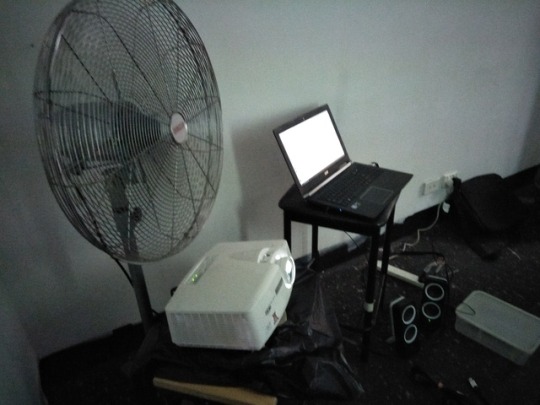

Setting up the room can with some technical difficulties, but the tests went well before the finial presentation
0 notes
Text
Experimentation
During our preparations before the presentation we had a week of very stormy weather. This was perfect for recording an actual storm instead of replicating the sounds completely artificially, for a strengthened experience of the natural event.
We experimented with the editing of these sounds, as well as the use of strobe lights and video and still photos for projections.
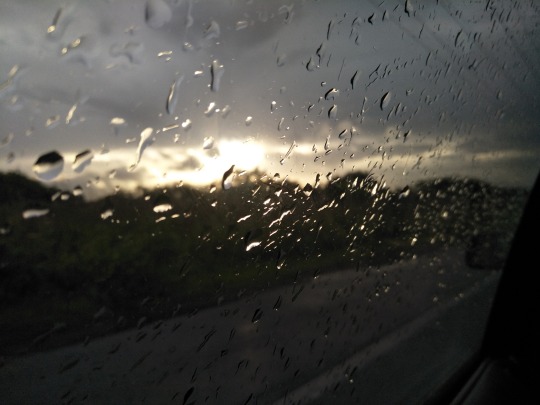
As a group we explored different material options within the surrounding shops on campus, finding light, thin fabrics in while, grey and black that could represent storm clouds and ass a visual, textual sensory element to our work. Fishing wire for hanging them will allow a 'floating' effect like a natural cloud, while thin streamers would catch air movement better for a more kinetic appearance.



0 notes
Text
Installation and textile research 3
Eline Bass, 'still', n/a, textiles, https://elainebuss.com/artwork/4178560.html
"This installation was made of panels of hanging silk hung in concentric circles. Viewers walked through the labyrinth of fabric to reach an open space in the center. As one entered, the outside environment was gradually obscured through the layering of the silk. In the center, the space was quiet, literally and figuratively. The silk absorbed outside sounds, and the body was enveloped in delicate white fabric. Sensory information was minimal, enriching what was present. As viewers made their slow emersion, the exterior environment slowly came back into focus"
The use of hanging textiles first came to mind with the thought of representing cloud formations. This artwork creates a natural looking form that includes the audience through their exploration, however our use of textiles would be more limited as our use of sound needs to be an active, prominent element.


https://youtu.be/ib4SiDWo398
youtube
Ann Hamilton, 'the event of a thread', n/a, armory park Wade Thompson Drill Hall, http://www.neverthelessnation.com/2012/12/ethereal-media-art-installation-event.html
This artwork explores the inclusion of the audience within the function of the artwork, and mimics natural movement and flow through fabric and kinetic energy. The use of airflow or the audience to more layers of hanging fabric might be a an interesting aspect to inclue within our finial artwork
Lee Boroson, 'plastic fantastic', 1963, MASS MoCA, http://www.aestheticamagazine.com/imitating-natural-world/
"A new exhibition of works by the artist Lee Boroson at MASS MoCA explores human representations of the natural world through large-scale sculptural installations"
"In the contemporary German philosopher Peter Sloterdijk’s mammoth magnum opus Spheres (1998),he repeatedly comes back to the bubble and the sphere as metaphors for the way we live our lives on the cusp of inner and outer worlds, always absorbed within our inner world while at the same time existing within an outer sphere – the external environment. As an environmentally-engaged philosopher, his comments are prescient not just to an understanding of the concerns underlying contemporary environmental art but also to some of the specific dialogues about the presentation of ecological art either within or outside of the gallery space, where the gallery can be seen as an other sphere, somewhere between the inner and outer spheres. Recent developments in ecological and environmental art have generally resulted in creative work being placed outside of the gallery and into the natural or urban environments. However, as a new exhibition entitled Plastic Fantastic by Lee Boroson (b. 1963) at MASS MoCA reveals, there is a movement within ecologically-engaged sculpture and installation art which explores bringing interrogations of the natural environment back into the gallery with surprising and thought-provoking results. Plastic Fantastic is one of Boroson’s most ambitious projects yet, invoking and recreating four distinct ecological phenomena within the MASS MoCA gallery rooms."
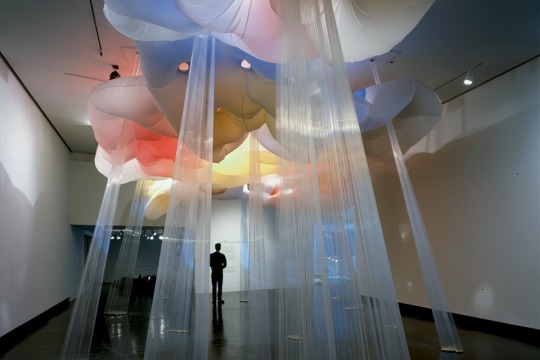
Boroson's installation used the natural elements of air to inflate plastic and create a representation of ecology. While we would like our artwork to have a more natural feeling to better replicate the experience, although artificially, the use of decorating a space for the audience to navigate and the understanding of ecologies behind the work will be influential to our finial work.
0 notes
Video
vimeo
INSIDEOUT | Palais de Tokyo | Olympus Perspective Playground in Paris from flora&faunavisions on Vimeo.
Research 2
Thinking of other elements we can include in our assessment we considered visual.
The use if projections was something we wanted to experiment with, this would allow us to work with light for a varying effect of nature and create a more immersive experience.
0 notes
Text
0 notes
Text
Group experiment

Outside of class we met up to experiment with different aspects of our artwork. Booking a room to use for the finial installation, we researched the type of recourses we can use from the campus and sourced multiple pedestal fans we can use to replicate movement and winds found in a storm. Experimenting with the strength and placement of the fan in the room proved successful, however it was very loud with few settings and would need a louder sound element to overcome the unwanted noise. We also experimented with different speaker systems from the tool room, which were very effective within the space.
We then considered other elements we could include within our artwork to better express a storm and create an immersive experience
0 notes
Text
Storm installation research
Symphony in D Minor, by Patrick Gallagher and Chris Klapper. Uses video and sound, the hanging cylinders respond to movement, intensifying the effects of heavy rain, lightning, and thunder as the audience leaps and flails beneath.

Rain Room, by art collective Random International, aims to keep you dry. Its motion sensors detect the position of visitors' bodies, ensuring that they never get wet.

Blow Up is a marvel of an art installation by Scott Sona Snibbe that amplifies breathing into a roomful of wind. Visitors blow into a tiny array of impellers which, in turn, controls the intensity of a larger array of electric fans to create one very cool effect.
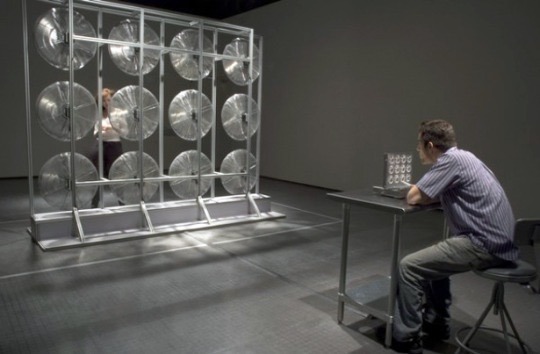

All these works expressed how natural weather can be replicated artificially, and how these replications of the world adjust and combine the human presence. These works all include the audience, which would be an interesting idea for our own artwork through our theme of ecology.
Bibiliography:
MATTHEW BOWER, A Storm in a Jar, The Atlantic, NOV 9, 2012
https://www.theatlantic.com/entertainment/archive/2012/11/a-storm-in-a-jar-10-very-cool-art-installations-that-imitate-weather/265017/
0 notes
Text
Assessment 3
As a group we needed to make a time based artwork, based on an event and a weekly class concept.
We brainstormed which ideas we wanted to work with, all coming to simple solutions we wanted to make:
An installation, through the decoration of a room or space to include the audience and express our event as a shared experience with the class. We were all interested in the format of an installation because it was vague and broad, letting us work with a multitude of different options, materials and mediums.
Week 10 (static, noise, interference, glitch) or Week four (ecologies) as are base concept.
We were all interested in the use of audio in place of visual and thought to include this aspect in our experimentations.
After considering installations, one of our first ideas was replicating a storm. A storm is a time based event everyone is familiar with varying perceptions and opinions, and includes multiple aspects of nature that would be interesting to try and mimic artificially within our installation space to share the experience with our audience. After discussing our artwork with Pia in class we decided to work in the weekly concept of ecologies, as this will allow us to focus on the replication of a storms natural environment and how we can adapt it soley for the human presence.
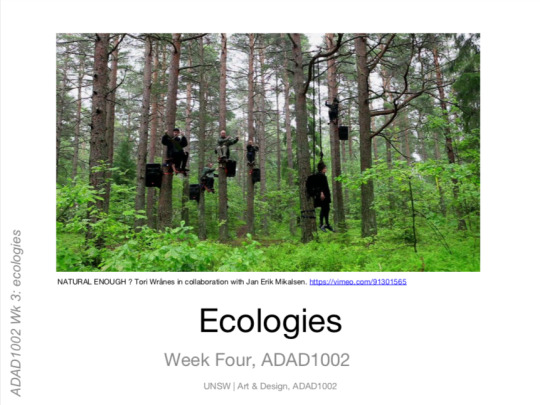
0 notes
Text
Week 11-Desire
Taking inspiration from Marcel Duchamp's artwork 'Coin Dr chasetè', we took undesirable materials and combined them to produce an object that was desirable.
He created this desire through Walter Benjamin's understanding of anthropomorphism within design, making plastic bags turn into a kinetic work, resembling a live, moving fish.
2 notes
·
View notes
Text
Week 10
Using something in a broken way-
Using a reusable cup to hold a plastic cup
0 notes
Text
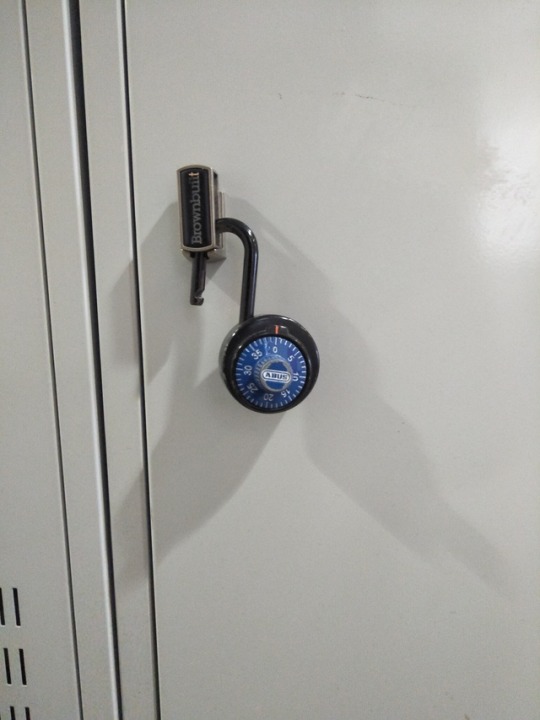
Week 10
Using a tool in a broken way-a lock is meant to keep a door closed but it was left unlocked on the handle
0 notes
Text
Artist statement
Throughout history our socially constructed binaries have shaped the way we perceive the world. However, within our contemporary age these 'pre-perceptions' are continuously challenged by artists and designers, who blur the line between set binaries and their defining conflictions.
Artists such as Austin Lee, Theo Jansen, Joshua Allen-Harrisand Kara Walker have influenced my work through their exploration of 'organic life' and synthetic objects within art and how far this influenced perception can be challenged. This perception is particularly relevant in our modern, technological era, as our sense of what is 'real' or 'organic' is constantly tested with the adaption of the digital within our environment, which forces us to question the very definition of 'real'.
In my work I continue to explore this concept of social binaries through the understanding of 'organic' compared to 'man-made', and the similarities found outside their opposing definitions through the representation and questioning of such social binaries.
My artwork, ‘Window view’, represents this constructed perspective through the shared expression of my own personal, every day view, which I see through my bedroom window. This scene can relate directly to the audience, not only from the depiction of the common town and Australian landscape but forces individual reflection and comparison of the natural and man-made within our own, everyday window view. This contemplation of our own experiences allows an understanding of the role of social binaries within our everyday and continues to question our perception.
This is emphasized within my artwork through the use of its curve, as the flexible base moves around a corner compared to the usual flat form, utilizing its translucent material to create a synthetic window inside the room. The 3D inclusion of power lines also exaggerates this perspective as it forces a recognized depth to the environment through layering and it’s connected form.
My artwork consists of similarly conflicting mediums and techniques to challenge our perspective of their depiction, as well as their roles as synthetic and organic materials. The expression of man-made objects in my scene, such as houses, the telegraph tower and power lines, are created using raw yarn and undyed, cotton thread. The use of natural colours and rough, hairy textures allow its instant recognition as an ‘organic’ material, contrary to its depictions. In contrast, all depictions of nature, such as the tree line and Australian Gullahs, are all made of recycled, translucent plastics. Their bright colours, such as neon green and pink, stand out against the clear base and natural stings, forcing the viewer to recognize their composition and follow the vector lines of their edges to further exaggerate their overwhelming presence within the artwork. Vague shapes and use of silhouettes are also used emphasize their synthetic medium, and allow a constructed, lifeless feel through their specific layering and geometric edges. The birds appear detailed through their individually cut feathers, which adds interest to their form, but fails to capture the character of a living creature through their still construction. Their inclusion, as national Australian birds, also adds to the depiction of an Australian landscape, and further relation to the audience from it’s familiarity.
The artwork is constructed with sewing, both hand and machine, as well as glue and double-sided tape. Sewing is commonly seen as more personal through the use of unique, imperfect stitching. This connotation was used within the construction of the man-made, which conflicts with it’s actual construction by machines in reality. A more synthetic binding of glue and tape was used to attach the natural depictions in the scene, which not only emphasized it’s translucent quality, but allows an unrealistic construction which exaggerates the confliction of the social binary it represents.
My artwork encourages the audience to question their own, personal lives and perspective of the world. Though it’s window representation, my artwork allows as universal relation from the audience, symbolizing their view of society through the deliberate expression of a local community. This forces comparison and self-reflection of the world we live in, allowing us to see past set binaries such as ‘synthetic and organic’ and blur the conflicting lines between them to further understand their role in our world.
Bibliography/ referencing
Austin Lee, ‘Serious Works’exhibition, march 2017, https://www.itsnicethat.com/articles/austin-lee-art-140717
Austin Lee, ‘Smother’, acrylic on canvas, 2015, https://www.itsnicethat.com/articles/austin-lee-art-140717
Calvin Nicholls, “Birds in art”,poster exhibition, 2017, http://www.calvinnicholls.com/567256/art-museum-and-gallery-shows/
Dorea Reeser, Natural versus Synthetic Chemicals Is a Gray Matter, April 10, 2013, https://blogs.scientificamerican.com/guest-blog/natural-vs-synthetic-chemicals-is-a-gray-matter/
Theo Jansen, kinetic sculpture, ‘Strandbeest’ (1990), 2016 exhibition, https://www.exploratorium.edu/strandbeest)
Sprout, Green Art Installations: Air Bear and Other Inflatable Bag Art, March 22nd, 2013, http://ldsearthstewardship.org/2013/03/green-art-installations-air-bear-and-other-inflatable-bag-art/)
Joshua Allen-Harris, kinetic sculpture, ‘Air bear’ 2008, http://ldsearthstewardship.org/2013/03/green-art-installations-air-bear-and-other-inflatable-bag-art/)
Kara Walker, Gone: An Historical Romance of a Civil War as It Occurred between the Dusky Thighs of One Young Negress and Her Heart‘, 1994, http://www.melissahuang.com/2011/11/06/women-in-art-kara-walker/
Melissa Huang, “Women in art: Kara Walker”, 2011,http://www.melissahuang.com/2011/11/06/women-in-art-kara-walker/
Singing wings aviary gallery, n/a, http://www.singing-wings-aviary.com/rose-breasted-cockatoo-galah.htm
Tony Rogers, how plastics are made and what we need to know about them, July 22, 2015, https://www.creativemechanisms.com/blog/how-plastics-are-made-and-what-you-need-to-know-about-them
0 notes